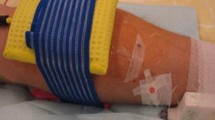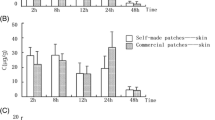Abstract
Aims
Accumulation of advanced glycation endpoints is a trigger to the development of diabetic peripheral neuropathy, which is a common complication of diabetes. Oral administration of benfotiamine (BFT) has shown some preclinical and clinical promise as a treatment for diabetic peripheral neuropathy. The purpose of this study was to evaluate the method of transdermal delivery of BFT as a possible, viable route of administration for the treatment of diabetic peripheral neuropathy.
Methods
A single application of 10 mg of BFT was given to guinea pigs topically. The levels of thiamine (T), thiamine monophosphate, thiamine diphosphate, S-benzoylthiamine and BFT were measured in the blood, skin and muscle at different time points within 24 h.
Results
At the 24-h time point, following the single BFT dose, the T level was increased 10× in the blood, more than 7× in the skin and almost 4× in the muscle compared to the untreated animals. The total T content (total) was increased 7× in the blood, 17× in the skin and 3× in the muscle compared to the untreated animals.
Conclusions
This strong increase in the tissue levels of T and the associated metabolic derivatives levels found in the blood and local tissues following a single dose indicate that topically applied BFT may be a viable and advantageous delivery method for the treatment of diabetic peripheral neuropathy.



Similar content being viewed by others
References
Head KA (2006) Peripheral neuropathy: pathogenic mechanisms and alternative therapies. Altern Med Rev 11(4):294–329
Tesfaye S, Boulton AJ, Dickenson AH (2013) Mechanisms and management of diabetic painful distal symmetrical polyneuropathy. Diabetes Care 36(9):2456–2465
Vincent AM, Calabek B, Roberts L, Feldman EL (2013) Biology of diabetic neuropathy. Handb Clin Neurol 115:591–606
Cameron NE, Gibson TM, Nangle MR, Cotter MA (2005) Inhibitors of advanced glycation end product formation and neurovascular dysfunction in experimental diabetes. Ann N Y Acad Sci 1043:784–792
Duran-Jimenez B, Dobler D, Moffatt S et al (2009) Advanced glycation endproducts in extracellular matrix proteins contribute to the failure of sensory nerve regeneration in diabetes. Diabetes 58:2893–2903
Stracke H, Hammes HP, Werkmann D et al (2001) Efficacy of benfotiamine versus thiamine on function and glycation products of peripheral nerves in diabetic rats. Exp Clin Endocrinol Diabetes 109(6):330–336
Pomero F, Molinar Min A, La Selva M, Allione A, Molinatti GM, Porta M (2001) Benfotiamine is similar to thiamine in correcting endothelial cell defects induced by high glucose. Acta Diabetol 38(3):135–138
Beltramo E, Berrone E, Buttiglieri S, Porta M (2004) Thiamine and benfotiamine prevent increased apoptosis in endothelial cells and pericytes cultured in high glucose. Diabetes Metab Res Rev 20(4):330–336
Gadau S, Emanueli C, Van Linthout S et al (2006) Benfotiamine accelerates the healing of ischaemic diabetic limbs in mice through protein kinase B/A kt-mediated potentiation of angiogenesis and inhibition of apoptosis. Diabetologia 49(2):405–420
Sánchez-Ramírez GM, Caram-Salas NL, Rocha-González HI et al (2006) Benfotiamine relieves inflammatory and neurophathic pain in rats. Eur J Pharmacol 530(1–2):48–53
Karachalias N, Babaei-Jadidi R, Kupich C, Ahmed N, Thornalley PJ (2005) High-dose thiamine therapy counters dyslipidemia and advanced glycation of plasma protein in streptozotocin-induced diabetic rats. Ann N Y Acad Sci 1043:777–783
Stirban A, Negrean M, Stratmann B et al (2006) Benfotiamine prevents macro- and microvascular endothelial dysfunction and oxidative stress following a meal rich in advanced glycation end products in individuals with type 2 diabetes. Diabetes Care 29(9):2064–2071
Stracke H, Gaus W, Achenbach U, Federlin K, Bretzel RG (2008) Benfotiamine in diabetic polyneuropathy (BENDIP): results of a randomised, double blind, placebo-controlled clinical study. Exp Clin Endocrinol Diabetes 116(10):600–605
Haupt E, Ledermann H, Köpcke W (2005) Benfotiamine in the treatment of diabetic polyneuropathy—a three-week randomized, controlled pilot study (BEDIP study). Int J Clin Pharmacol Ther 43(2):71–77
Du X, Edelstein D, Brownlee M (2008) Oral benfotiamine plus alpha-lipoic acid normalises complication-causing pathways in type 1 diabetes. Diabetologia 51(10):1930–1932
Hammes HP, Du X, Edelstein D et al (2003) Benfotiamine blocks three major pathways of hyperglycemic damage and prevents experimental diabetic retinopathy. Nat Med 9(3):294–299
Babaei-Jadidi R, Karachalias N, Ahmed N, Battah S, Thornalley PJ (2003) Prevention of incipient diabetic nephropathy by high-dose thiamine and benfotiamine. Diabetes 52:2110–2120
Karachalias N, Babaei-Jadidi R, Kupich C, Ahmed N, Thornalley PJ (2005) High dose thiamine therapy counters dyslipidemia and advanced glycation of plasma protein in streptozotocin-induced diabetic rats. Ann N Y Acad Sci 1043:777–783
Booth AA, Khalifah RG, Hudson BG (1996) Thiamine pyrophosphate and pyridoxamine inhibit the formation of antigenic advanced glycation end-products: comparison with aminoguanidine. BioChem Biophys Res Commun 220:113–119
Wu S, Ren J (2006) Benfotiamine alleviates diabetes-induced cerebral oxidative damage independent of advanced glycation end-product, tissue factor and TNF-Alpha. Neurosci Lett 394(2):158–162
Berg JM, Tymoczko JL, Stryer L (2002) Biochemistry, 5th edn. WH Freeman, New York
Loew D (1996) Pharmacokinetics of thiamine derivatives especially of benfotiamine. Int J Clin Pharmacol Ther 34(2):47–50
Rabbani N, Shahzad Alam S, Riaz S et al (2009) High dose thiamine therapy for patients with type 2 diabetes and microalbuminuria: a pilot randomised, double-blind, placebo-controlled study. Diabetologia 52:208–212
Smithline H, Donnino M, Greenblatt D (2012) Pharmacokinetics of high-dose oral thiamine hydrochloride in healthy subjects. BMC Clin Pharmacol 12:4
Volvert ML, Seyen S, Piette M et al (2008) Benfotiamine, a synthetic S-acyl thiamine derivative, has different mechanisms of action and a different pharmacological profile than lipid-soluble thiamine disulfide derivatives. BMC Pharmacol 8:10
Rabbani N, Thornalley PJ (2011) Emerging role of thiamine therapy for prevention and treatment of early-stage diabetic nephropathy. Diabetes Obes Metab 13:577–583
Babaei-Jadidi R, Karachalias N, Kupich C, Ahmed N, Thornalley PJ (2004) High dose thiamine therapy counters dyslipidaemia in streptozotocin-induced diabetic rats. Diabetologia 47:2235–2246
Fraser DA, Diep LM, Hovden IA et al (2012) The effects of long-term oral benfotiamine supplementation on peripheral nerve function and inflammatory markers in patients with type 1 diabetes: a 24-month, double-blind, randomized, placebo-controlled trial. Diabetes Care 35(5):1095–1097
Ziems M, Netzel M, Bitsch I (2000) Biokinetic parameters and metabolism of S-benzoylthiamine-O-monophosphate. BioFactors 11:109–110
Shindo H, Okamoto K, Ji Totsu (1967) Transport of organic compounds through biological membranes. I. Accumulative uptake of S-benzoylthiamine by human erythrocytes. ChemPharmBull 15:295–302
Herve C, Beyne P, Delacoux E (1994) Determination of thiamine and its phosphate esters in human erythrocytes by high-performance liquid chromatography with isocratic elution. J Chromatogr B 653:217–220
Lynch PLM, Trimble ER, Young IS (1997) High-performance liquid chromatographic determination of thiamine diphosphate in erythrocytes using internal standard methodology. J Chromatogr B 701:120–123
Talwar D, Davidson H, Cooney J, JO’Reilly D (2000) Vitamin B1 status assessed by direct measurement of thiamin pyrophosphate in erythrocytes or whole blood by HPLC: comparison with erythrocyte transketolase activation assay. Clin Chem 46(5):704–710
Van Landeghem BAJ, Puts J, Claessens HA (2005) The analysis of thiamin and its derivatives in whole blood samples under high pH conditions of the mobile phase. J Chromatogr B 822:316–321
Ziems M, Netzel M, Peter S, Bitsch I (1995) Entwicklung einer HPLC-Method zur Bestimmung von Benfotiamin und seinem Metaboliten S-Benzoylthiamin in menschlichem Vollblut. Vitamine und Zusatzstoffe in dr Ernährung von Mensch und Tier, 5. Symposium Jena, pp 320–323
Rogers EF (1972) Modified thiamines. In: Sebrell WH, Harris RS (eds) The vitamins: chemistry, physiology, pathology, methods. Academic Press, New York, pp 130–133
Frank T, Bitsch R, Maiwald J, Stein G (2000) High thiamine diphosphate concentrations in erythrocytes can be achieved in dialysis patients by oral administration of benfotiamine. Eur J Clin Pharmacol 56(3):251–257
Beltramo E, Berrone E, Tarallo S, Porta M (2008) Effects of thiamine and benfotiamine on intracellular glucose metabolism and relevance in the prevention of diabetic complications. Acta Diabetol 45(3):131–141
Jung EH, Takeuchi T, Nishino K, Itokawa Y (1988) Studies on the nature of thiamine pyrophosphate binding and dependency on divalent cations of transketolase from human erythrocytes. Int J Biochemistry 20(11):1255–1259
Acknowledgments
All funding for this research was provided by BioChemics, Inc.
Conflict of interest
The authors declare that they have no conflict of interest.
Ethical standard
All human and animal studies have been performed in accordance with the ethical standards of the responsible committee on animal experimentation (institutional and national) and with the Helsinki Declaration of 1975, as revised in 2008 (5).
Informed consent
Informed consent was obtained from all patients for being included in the study.
Author information
Authors and Affiliations
Corresponding author
Additional information
Managed by Massimo Federici.
Rights and permissions
About this article
Cite this article
Zhu, Z., Varadi, G. & Carter, S.G. Pharmacokinetics of the transdermal delivery of benfotiamine. Acta Diabetol 53, 317–322 (2016). https://doi.org/10.1007/s00592-015-0776-2
Received:
Accepted:
Published:
Issue Date:
DOI: https://doi.org/10.1007/s00592-015-0776-2




